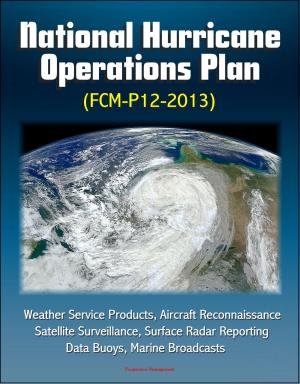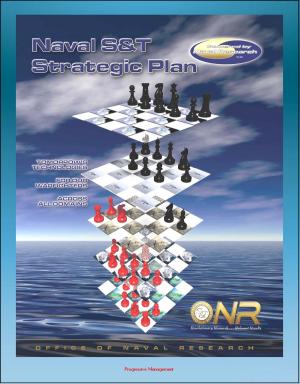21st Century U.S. Military Documents: Antiterrorism (Air Force Instruction 10-245 21) - AT Program, Standards, Force Protection, Terrorist Threat Levels, Suspicious Activity
Nonfiction, Social & Cultural Studies, Political Science| Author: | Progressive Management | ISBN: | 9781301558247 |
| Publisher: | Progressive Management | Publication: | October 12, 2013 |
| Imprint: | Smashwords Edition | Language: | English |
| Author: | Progressive Management |
| ISBN: | 9781301558247 |
| Publisher: | Progressive Management |
| Publication: | October 12, 2013 |
| Imprint: | Smashwords Edition |
| Language: | English |
This instruction establishes guidance and procedures for the Air Force Antiterrorism Program and supports the Department of Defense AT Program. The AT Program is a high priority, comprehensive program which focuses on defensive measures to reduce the risk to AF personnel and property to terrorist acts. The guidance and procedures for AT risk management provide guidance on collecting and disseminating timely terrorist threat information, guide development and support the implementation of comprehensive AT plans, ensure AT training and exercises for all AF members, provide guidance for allocation and application of AT resources, and establish procedures for comprehensive AT program reviews.
AT Responsibility. AT is a command responsibility which must be thoroughly integrated into every unit mission. Commanders and equivalents at all levels have the responsibility and authority to enforce appropriate AT standards and measures. Commanders and equivalents must be aware of evolving threats against their command and continually review their AT posture using the Integrated Defense Risk Management Process (IDRMP), to manage risk and appropriately adjust the posture of elements and personnel subject to their control. The next level up the chain of command must be notified and mitigate or accept any AT risk that cannot be controlled to an acceptable level within a commander's resources.
Chapter 1 * AIR FORCE ANTITERRORISM PROGRAM * 1.1. Air Force Antiterrorism Program * 1.2. AT Responsibility * 1.3. AF AT Program Policy * 1.4. AT Program Roles and Responsibilities * Chapter 2 * ANTITERRORISM STANDARDS * 2.1. Standard 1 * 2.2. Standard 2 * 2.3. Standard 3 * 2.4. Standard 4 * 2.5. Standard 5 * 2.6. Standard 6 * 2.7. Standard 7 * 2.8. Standard 8 * 2.9. Standard 9 * 2.10. Standard 10 * 2.11. Standard 11 * 2.12. Standard 12 * 2.13. Standard 13 * 2.14. Standard 14 * 2.15. Standard 15 * 2.16. Standard 16 * 2.17. Standard 17 * 2.18. Standard 18 * 2.19. Standard 19 * 2.20. Standard 20 * 2.21. Standard 21 * 2.22. Standard 22 * 2.23. Standard 23 * 2.24. Standard 24 * 2.25. Standard 25 * 2.26. Standard 26 * 2.27. Standard 27 * 2.28. Standard 28 * 2.29. Standard 29 * 2.30. Standard 30 * 2.31. Standard 31 * 2.32. Standard 32 * Attachment 1 * GLOSSARY OF REFERENCES AND SUPPORTING INFORMATION * Attachment 2 * FORCE PROTECTION CONDITION (FPCON) MEASURES * Attachment 3 * TERRORIST THREAT LEVELS * Attachment 4 * RISK MANAGEMENT AND RESOURCING PROCESSES * Attachment 5 * AF APPROVED LEVEL II - ATO CERTIFICATION TRAINING COURSES * Attachment 6 * THE ANTITERRORISM STANDARDS FOR BUILDINGS DEVIATION PROGRAM * Attachment 7—CATEGORIES OF SUSPICIOUS ACTIVITY
This instruction establishes guidance and procedures for the Air Force Antiterrorism Program and supports the Department of Defense AT Program. The AT Program is a high priority, comprehensive program which focuses on defensive measures to reduce the risk to AF personnel and property to terrorist acts. The guidance and procedures for AT risk management provide guidance on collecting and disseminating timely terrorist threat information, guide development and support the implementation of comprehensive AT plans, ensure AT training and exercises for all AF members, provide guidance for allocation and application of AT resources, and establish procedures for comprehensive AT program reviews.
AT Responsibility. AT is a command responsibility which must be thoroughly integrated into every unit mission. Commanders and equivalents at all levels have the responsibility and authority to enforce appropriate AT standards and measures. Commanders and equivalents must be aware of evolving threats against their command and continually review their AT posture using the Integrated Defense Risk Management Process (IDRMP), to manage risk and appropriately adjust the posture of elements and personnel subject to their control. The next level up the chain of command must be notified and mitigate or accept any AT risk that cannot be controlled to an acceptable level within a commander's resources.
Chapter 1 * AIR FORCE ANTITERRORISM PROGRAM * 1.1. Air Force Antiterrorism Program * 1.2. AT Responsibility * 1.3. AF AT Program Policy * 1.4. AT Program Roles and Responsibilities * Chapter 2 * ANTITERRORISM STANDARDS * 2.1. Standard 1 * 2.2. Standard 2 * 2.3. Standard 3 * 2.4. Standard 4 * 2.5. Standard 5 * 2.6. Standard 6 * 2.7. Standard 7 * 2.8. Standard 8 * 2.9. Standard 9 * 2.10. Standard 10 * 2.11. Standard 11 * 2.12. Standard 12 * 2.13. Standard 13 * 2.14. Standard 14 * 2.15. Standard 15 * 2.16. Standard 16 * 2.17. Standard 17 * 2.18. Standard 18 * 2.19. Standard 19 * 2.20. Standard 20 * 2.21. Standard 21 * 2.22. Standard 22 * 2.23. Standard 23 * 2.24. Standard 24 * 2.25. Standard 25 * 2.26. Standard 26 * 2.27. Standard 27 * 2.28. Standard 28 * 2.29. Standard 29 * 2.30. Standard 30 * 2.31. Standard 31 * 2.32. Standard 32 * Attachment 1 * GLOSSARY OF REFERENCES AND SUPPORTING INFORMATION * Attachment 2 * FORCE PROTECTION CONDITION (FPCON) MEASURES * Attachment 3 * TERRORIST THREAT LEVELS * Attachment 4 * RISK MANAGEMENT AND RESOURCING PROCESSES * Attachment 5 * AF APPROVED LEVEL II - ATO CERTIFICATION TRAINING COURSES * Attachment 6 * THE ANTITERRORISM STANDARDS FOR BUILDINGS DEVIATION PROGRAM * Attachment 7—CATEGORIES OF SUSPICIOUS ACTIVITY















